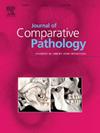含表皮生长因子的纤维蛋白样细胞外基质1源性淀粉样变性伴致死性胃出血1例对马豹(Prionailurus bengalensis euptilurus)
IF 0.9
4区 农林科学
Q4 PATHOLOGY
引用次数: 0
摘要
含有表皮生长因子的纤维蛋白样细胞外基质1 (EFEMP1)衍生淀粉样变性导致人类胃肠道出血。对马豹(Prionailurus bengalensis euptilurus)和恒河猴(Macaca mulatta)也有淀粉样变的报道。然而,人类和动物的临床症状和病变不同。一只圈养对马豹,19岁,因胃溃疡出血死亡,并进行了病理分析。淀粉样蛋白沉积在全身器官,尤其是胃和肠的静脉壁和间质中。淀粉样蛋白呈弱嗜碱性透明样物质,呈刚果红染色。免疫组织化学和液相色谱-串联质谱分析显示,淀粉样蛋白由N端和c端EFEMP1肽组成。淀粉样蛋白原纤维约10纳米宽,无分枝,短且随机排列。患者死于efemp1源性淀粉样变引起的胃出血。这些发现表明,对马豹中efemp1衍生的淀粉样变性具有与受影响的人类相似的病理特征,包括淀粉样蛋白主要沉积在静脉壁和致命的胃肠道出血。本文章由计算机程序翻译,如有差异,请以英文原文为准。
Epidermal growth factor-containing fibulin-like extracellular matrix 1-derived amyloidosis with fatal gastric bleeding in a Tsushima leopard cat (Prionailurus bengalensis euptilurus)
Epidermal growth factor-containing fibulin-like extracellular matrix 1 (EFEMP1)-derived amyloidosis causes gastrointestinal bleeding in humans. Amyloidosis has also been reported in the Tsushima leopard cat (Prionailurus bengalensis euptilurus) and rhesus macaque (Macaca mulatta). However, the clinical signs and lesions in humans and animals differ. A captive Tsushima leopard cat, aged 19 years, died of haemorrhage due to a gastric ulcer and a pathological analysis was performed. Amyloid was deposited in the venous walls and interstitium of the systemic organs, especially the stomach and intestines. The amyloid appeared as a weakly basophilic hyaline-like substance and stained with Congo red. Immunohistochemistry and liquid chromatography-tandem mass spectrometry revealed that the amyloid was composed of both N- and C-terminal EFEMP1 peptides. The amyloid fibrils were approximately 10 nm wide, unbranched, short and randomly arranged. The patient died from gastric bleeding caused by EFEMP1-derived amyloidosis. These findings suggest that EFEMP1-derived amyloidosis in Tsushima leopard cats has pathological features similar to those in affected humans, including amyloid deposition predominantly in the walls of veins and fatal gastrointestinal bleeding.
求助全文
通过发布文献求助,成功后即可免费获取论文全文。
去求助
来源期刊
CiteScore
1.60
自引率
0.00%
发文量
208
审稿时长
50 days
期刊介绍:
The Journal of Comparative Pathology is an International, English language, peer-reviewed journal which publishes full length articles, short papers and review articles of high scientific quality on all aspects of the pathology of the diseases of domesticated and other vertebrate animals.
Articles on human diseases are also included if they present features of special interest when viewed against the general background of vertebrate pathology.

 求助内容:
求助内容: 应助结果提醒方式:
应助结果提醒方式:


